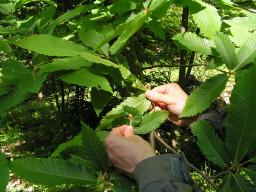Experts are warning that an outbreak of parasite wasps from China could doom Italian chestnut trees to extinction.
''Native chestnut groves are destined to disappear,'' Roberto Botta, a professor of arboriculture at the University of Turin, told a recent meeting of chestnut growers and researchers in Florence.
Chestnut trees account for 10% of Italian forests, covering nearly 2,000 acres spanning all of Italy's twenty regions.
Believed to have come to Europe from China as a stowaway aboard imported tree saplings, the oriental chestnut gall wasp (Dryocosmus kuriphilus Yasumatsu) is the autumn fruit's worst enemy, according to Italian chestnuts growers.
The insect emerges between the end of May and July to deposit its eggs in the trees' twig shoots and buds, transforming the would-be chestnuts into larva-filled lumps called ''galls''.
The parasite made its European debut in the Piedmont region of Italy in 2002 where it has nearly wiped out a number of local orchards.
''Production at hard-hit chestnut stands in the Piedmont have fallen by as much as 80%,'' according to Luigi Bersellini of the national chestnut growers' association Citta' del Castagno.
Bersellini said the gall wasps have been steadily making their way down the peninsula with new outbreaks registered as far south as Salerno in the Campania region.
Giovanni Bosio, who heads Piedmont's pest control service blamed the spread on the unregulated sale of contaminated chestnut products and blasted the continued lack of government intervention.
''Nurseries continue selling these products without anyone shedding light on the civil and criminal responsibilities for the environmental and economic disaster they are causing,'' Bosio said.
Combating gall wasp infestations has proven exceedingly difficult as the galls provide larvae with a protective shielding against pesticides.
The National Forestry Service says that there is little it can do apart from searching out and destroying infected plant material.
But a team of researchers at University of Turin led by Professor Alberto Alma are hoping for a little help from Mother Nature.
In 2005, they began experimenting with the release of another winged parasite from China and the gall wasp's natural predator, the Torymus sinensis, in a number of infested chestnut groves.
An unlikely savior, the Torymus implants its own eggs inside the galls where they hatch, unleashing the insect's gall-wasp devouring young.
The use of Torymus sinensis to combat gall waps was first tested in Japan during the 1980s where chestnut trees have since made a comeback.
Alba says that while the results have been very encouraging, the difficulty of breeding Torymus sinensis and the delicate timing required for their release make them a strictly long-term solution.
Nonetheless, Alba's colleague at the University of Turin, Professor Botta maintained that ''the only viable solution is to replace Italian chestnuts with Asian hybrids which are more resistant to infestation.''
With annual yields ranging from 50 to 70 million tons, Italy is the largest producer of chestnuts in Europe and the third largest in the world behind China and South Korea, according to the United Nations Food and Agricultural Organization.
Italy boasts seven different varieties of chestnuts with EU protected geographical status including the Marrone del Mugello of Tuscany and the Castagna Cuneo of the Piedmont.
Chestnuts have been a staple of the Italian diet for centuries making the October harvest an important part of the year.
According to the Citta' del Castagno, more than one hundred towns and villages around the country still celebrate the chestnut harvest with traditional festivals featuring medieval sporting events, costumed pageants, folk music and open-air banquets.
Chinese wasp threatens Italian chestnuts

Topic:
You may also be interested in...
Latest property in Italy
370 m²
7 Bedrooms
279000
210 m²
4 Bedrooms
135000
270 m²
4 Bedrooms
395000
0 m²
8 Bedrooms
1950000
0 m²
8 Bedrooms
0
What to do in Italy
Speak, live and enjoy Italian with Renata: homestay experience in the heart of Milan, in-person and online lessons
8-day Puglia small group guided tours, Southern Italy












